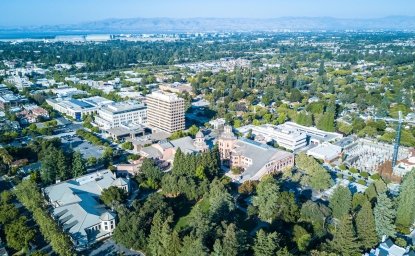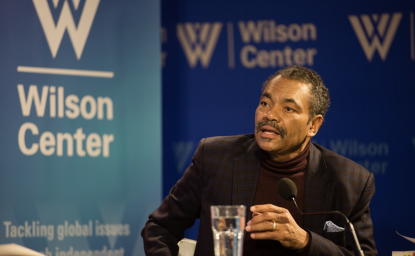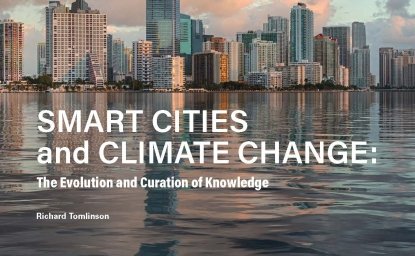Gordon Feller is Wilson Center Global Fellow and Co-Founder of Meeting of the Minds.
We’re in the midst of an exciting revolution that’s changing virtually everything about the way we work and live in cities. What’s happening to us all has various names—the Gartner Group calls it “the Nexus of Forces”; IDC Research refers to as “the Third Platform”. Others refer to it as “the Internet of Things (IoT) revolution”. Whatever name you choose, this could be the mother of all big transitions, and what’s driving it is the stitching together of a wide range of many different kinds of technology-driven disruptions.
One thing is clear, and it’s starting to get widely noticed: this process, stimulated by the emergence of low-cost connected technologies, is transforming our experience of cities as we’ve known them.
At its essence, IoT is the networked connection of people, process, data, and things. IoT brings together each of those elements – the people, the business processes, the data, and the things — to make networked connections more relevant and valuable. It turns information into actions, and these then create new capabilities, richer experiences, and unprecedented economic opportunity for everyone connected to the city.
By “things” we’re really talking about the sensors, devices, objects, etc.—and not only the devices themselves. IoT is about integrating front office and back office operations across the entire city in ways that ensure IT and network components are connected to the other systems — including the people, process and data. This enables smarter decisions.
The Main Factors Fueling the IoT Revolution:
Asset Utilization
Improving business processes in ways that reduce costs
Improving capital efficiency
Employee Productivity
-
Improving labor efficiency
-
Making every hour worked a more productive hour
Supply Chain and Logistics
- Improving process efficiency
- Reducing waste in supply chain
Customer Experience (which is more than just the addition of more customers)
- Improving customer lifetime value
- Additional market share (adding more customers)
Innovation
- Improving the speed of research, development, and engineering; reducing time to market
- Creating new business models and new sources of revenue
To get the most value from IoT, city leaders are beginning to transform their organizations. Consider for a moment how much safer, more mobile, and more efficient our urban roads become when all of the disparate pieces are connected into an intelligent infrastructure.
To better understand the far-reaching impacts on cities of these emerging IoT-powered technologies, consider one question: What would happen if cities had available to them a wide range of affordable solutions, each of which enabled them to address their many challenges with roadway safety and decongestion?
IoT Powered Transportation Systems
Some cities are now using interoperable wireless communications networks that link up cars, buses, trucks, trains, emergency vehicles, personal mobile devices — molding them into a unified transportation infrastructure. Once in place, such a system does fundamentally change the transportation system paradigm –because it provides ordinary people with a broad range of new tools (including ones that are useful in the midst of driving, commuting, walking, or planning a trip). It makes urban travel faster, easier, more accessible, and environmentally friendlier.
As IoT grows and develops, a number of forces are driving massive shifts in transportation expectations and needs. These changes are being caused by advances in technology, and also by shifting socio-economic factors.
Technology is doing much more than simply increasing connectivity. As consumers of information, city resident and visitors all have personal devices and navigation systems. Some providers of technology-powered transit solutions argue that commuters probably have more information about current traffic status than the experts sitting inside the traffic management centers. Without better visibility into the real world conditions that prevail at this very moment, such managers can’t serve the citizen’s needs very well.
The networks that support mass transit, and that support public safety operations, have typically been built on proprietary solutions. Many of them were put in place decades ago. That means we have aging and disparate networks that are growing prohibitively expensive to operate and manage. It also means fragmented communications among the networks, which creates gaps in connectivity that introduce public safety risks to passengers, first responders, and citizens.
Urbanization is driving the need for more efficient transportation systems. With more people living in cities than in rural areas, traffic congestion is on the rise. Aging populations are placing new demands on mobility systems, especially wherever there are challenges associated with elderly access to healthcare and daily services. Meanwhile, global supply chains have disrupted traffic patterns in many countries. As economies move from insourcing to outsourcing, only to shift from outsourcing to insourcing, supply chains are then continually and dynamically being rerouted. This, in turn, is causing new trucking influxes, with logistics companies forced to handle the freight associated with those changes.
Public transit passengers now demand constant Wi-Fi connections to their devices while in transit. Transportation operators have to do more with less to keep transit ridership high while competing with private ridesharing companies. That means they need to attract more riders, continue to keep their operating costs down, and potentially rely on new business models.
As technology evolves, so do safety and security policies. Technology capabilities that were not available a few decades ago have emerged, and this requires public safety and security officials to upgrade their requirements if they want to take advantage of the most up-to-date technologies. Consider, for example, the challenges faced by the MedTIS corridor. From Venice to Lisbon, this system stretches for 6,800 km of motorways, supporting very diverse traffic (significant daily traffic, seasonal peaks, dense and growing heavy goods traffic). Disparity between geographies is particularly a challenge in areas like Europe, where one can easily drive from country to country to then discover disparate technologies and lack of interoperability causing supply chain disruption and logistics burdens. When traffic is moving at maximum performance there are tangible sustainability benefits, since drivers are not sitting in a congestion zone burning up tons of fossil fuels.
These trends and changes together imply that it’s now mission-critical for city-transportation agencies and public safety organizations to augment existing radio and limited data networks with video and real-time data solutions. That’s the best way for first responders and operators to have the contextual awareness they need in a variety of incidents, including life-threatening situations, as well as daily operations.
The Urban IoT Revolution
Reliable communication networks and services have long been a critical element in ensuring both the public welfare and our economic stability. Malicious attacks on the Internet, disruptions due to physical phenomena, software and hardware failures, and human errors all affect the proper functioning of essential public services that run over telecommunication networks. Such disruptions reveal the increased dependency of our cities on these networks and their services.
Where information lives, and how it is accessed, has been changing dramatically over these last few years. The convergence of all of Information Technology’s biggest megatrends (greater and greater Mobility, bigger Big Data, and growing high-speed Clouds) is resulting in the facts of life that we now take for granted: connecting more people, processes, data, and things than ever before. The result is nothing less than the IoT revolution.
In cities, this is already having some very positive impacts: enabling high levels of cross-sector collaboration (linking, for instance, new sources of energy with smart and connected electric vehicles); increasing efficiencies; expanding economic opportunities; reducing the harmful environmental impacts of human activity.
As a result of these new urban possibilities – all enabled by emerging digital technologies – cities are quickly becoming powerful IoT hubs as they integrate computing, networking, skills and culture; and spur innovation in areas as diverse as health, transport, and finance.
This series was originally published by Meeting of the Minds. To read the original article please click here.
Author

Founder, Meeting of the Minds

Urban Sustainability Laboratory
Since 1991, the Urban Sustainability Laboratory has advanced solutions to urban challenges—such as poverty, exclusion, insecurity, and environmental degradation—by promoting evidence-based research to support sustainable, equitable and peaceful cities. Read more

Explore More
Browse Insights & Analysis
Series: Part 2: Smart Cities Face a Dynamic Cybersecurity Landscape

Series: Part 3: Protecting Our Cities from Cyber Attacks

Dr. Maurice Jackson: The Sounds of Resistance Throughout History

